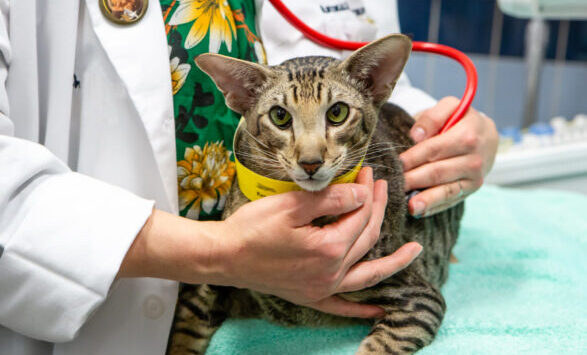Cognitive Dysfunction Syndrome (CDS) in Pets

Background
Senior pets, just like their human counterparts, can experience both physical and cognitive decline as they age. A disorder similar to Alzheimer’s disease in humans, Cognitive Dysfunction Syndrome (CDS) is a degenerative disease diagnosed in some dogs and cats. CDS causes a decline in brain function in aging pets, resulting in behavioral changes. This decline is not the result of normal aging – instead, pets with CDS have been shown to accumulate beta-amyloid plaques in the brain, which block normal communication between neurons (brain cells). This leads to various changes in behavior such as disorientation, changes in sleep patterns, memory loss, personality changes, and loss of housetraining. While there is no cure for CDS, early intervention can slow the progress of this disease and improve your pet’s quality of life throughout their senior years.
Risk Factors
All dogs and cats are at risk of developing CDS as they age. Signs of CDS can begin to show as early as 7 years in dogs and 10 years in cats.
Signs
The behavioral changes associated with cognitive dysfunction syndrome were originally classified using the acronym DISHA:
D – Disorientation
I – Interaction
S – Sleep-wake cycle
H – Housetraining
A – Activity
However, other behavioral changes can include memory and learning problems, appetite changes, anxiety, and depression. Below are common behavioral changes associated with CDS:
Disorientation
- Spatial disorientation – your pet may be confused about where they are. Some pets become trapped in corners or behind furniture, forget the location of their food/water/litter box, stare off into space or at walls, or pace back and forth.
- Temporal disorientation – your pet may be confused about what time it is (such as forgetting that they were just fed).
Interaction
- You may notice the interactions your pet has between yourself, people, and other pets have changed. This can include decreased social interaction, showing fear towards once familiar faces, and displaying aggression towards others.
Sleep-Wake Cycle
- Your pet may sleep more during the day and be awake at night.
- Your pet may wake in the middle of the night and start to wander, vocalize, or pace anxiously.
Housetraining
- House soiling is a common sign of CDS. Dogs can forget how to ask to go outside, and cats can forget where the litterbox is.
Activity
- Changes in activity level can include decreased grooming, being more sedentary, being more agitated, performing repetitive behaviors, vocalizing more often or for no clear reason, or being quiet when vocalizing would be considered normal.
Memory & Learning Problems
- Pets with CDS may forget previous training, such as basic commands, routines, or even their own name. Pets may also find it difficult to learn new activities.
Appetite Changes
- You may notice either an increase or decrease in appetite and trouble eating.
Anxiety & Depression
- You may notice your pet has become more anxious, either in general or amongst things that were once familiar to them.
- Pets may also have decreased responsiveness to stimuli.
Diagnosis
Cognitive dysfunction syndrome can only be diagnosed after eliminating other medical conditions that can result in behavioral changes. For example, if you notice your pet is urinating in inappropriate places, it could be a sign of bladder or kidney issues rather than CDS. A veterinarian will evaluate your pet and recommend tests in order to eliminate these other medical conditions and confirm a diagnosis of CDS.
Treatment
While there is no cure for CDS, pet owners can work with their veterinarian to develop a treatment plan to manage the behavioral changes associated with the disease and slow its progression.
Environmental Management & Enrichment
Pet owners should provide daily enrichment to increase their pet’s mental stimulation. This can include introducing puzzle feeders, new toys, different smells, going outside, clicker training, and playing with your pet.
Talk with your veterinarian about any physical limitations your pet has and how to modify your environment to accommodate their needs. For example, if your pet urinates in inappropriate places, consider more frequent trips outside, doggy pads throughout the home, or purchasing a larger litter box with lower sides or a litter box ramp. For those pets that have trouble reaching places or experience chronic pain, consider placing ramps in other locations in the home and raising food/water bowls to make mealtimes easier. Pets that are experiencing anxiety or showing aggression towards other people/pets in the household can also benefit from a private space in the home with their necessities where they can retreat or be placed for their comfort and safety.
Dietary Management
Commercial diets are available for pets that are experiencing cognitive decline. These diets will typically be rich in antioxidants to help improve cognitive function.
Supplements
Your veterinarian may recommend certain supplements to improve the signs of CDS in your pet. These supplements may include S-Adenosyl Methionine (SAMe), Phosphatidylserine, Apoaequorin, and/or Adrafinil.
Medication
The prescription drug Selegiline can be prescribed in the United States and Canada for pets with CDS.
Prevention
The earlier your pet is diagnosed with cognitive dysfunction syndrome, the better your chance of slowing its progression. It is recommended that owners take their senior pets for check-ups more frequently than their adult counterparts, at least once every six months as recommended by the American Animal Hospital Association (AAHA). Don’t assume changes in your pet’s behavior, activity, or appetite are “just old age.” Bring these changes to the attention of your veterinarian since early detection of disease can mean all the difference in extending quality of life for your pet.
As with any disease, research is needed to learn how to prevent the disease and improve its treatment. The Dog Aging Project is an initiative whose goal is to understand how genes, lifestyle, and environment influence aging in dogs. The information gathered from this initiative can be used to help dogs increase their healthspan (the period of life spent free from disease). A recent publication studied over 15,000 dogs in the Dog Aging Project database. Older dogs were more likely to score high on the Canine Social and Learned Behavior survey, an indicator of cognitive dysfunction. But more importantly, dogs rated by their owners as “not active” were over six times more likely to score high on the Canine Social and Learned Behavior survey when compared to dogs rated by their owners as “very active”. Just like humans, our pets’ brains require regular stimulation to stay healthy (use it or lose it). Keeping a predictable, daily routine that includes training, play, exercise, and a proper diet can help your senior pet maintain a good quality of life.
Make an Appointment































